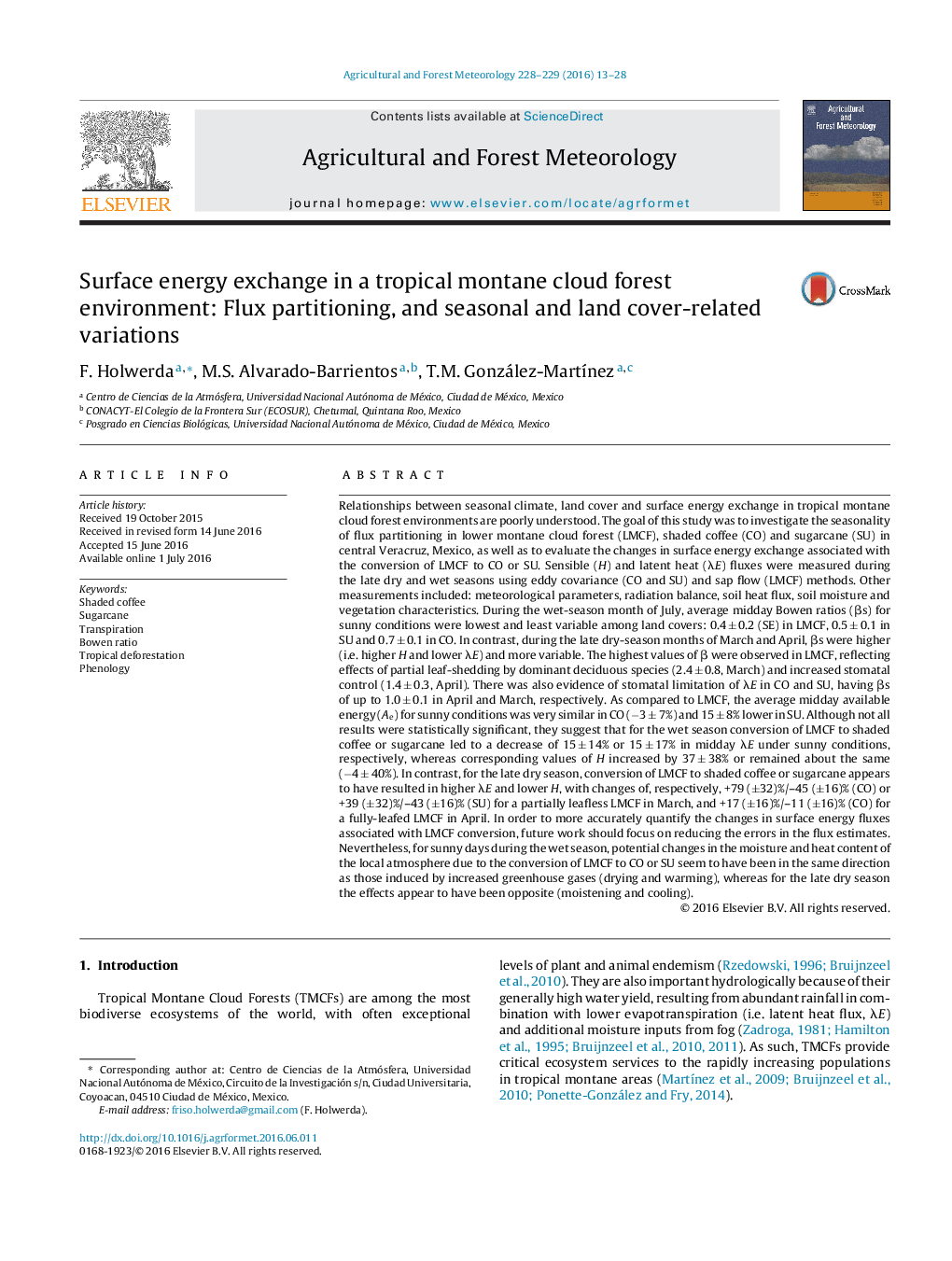| کد مقاله | کد نشریه | سال انتشار | مقاله انگلیسی | نسخه تمام متن |
|---|---|---|---|---|
| 6458180 | 158307 | 2016 | 16 صفحه PDF | دانلود رایگان |
- The surface energy balance of cloud forest, shaded coffee and sugarcane were studied.
- Wet season Bowen ratios (H/λE) were lowest and least variable among land covers.
- In all land covers, λE was lower and H higher during the late dry season.
- Late dry-season λE and H were lowest and highest, respectively, in the forest.
- High uncertainties in the flux estimates complicated comparisons among land covers.
Relationships between seasonal climate, land cover and surface energy exchange in tropical montane cloud forest environments are poorly understood. The goal of this study was to investigate the seasonality of flux partitioning in lower montane cloud forest (LMCF), shaded coffee (CO) and sugarcane (SU) in central Veracruz, Mexico, as well as to evaluate the changes in surface energy exchange associated with the conversion of LMCF to CO or SU. Sensible (H) and latent heat (λE) fluxes were measured during the late dry and wet seasons using eddy covariance (CO and SU) and sap flow (LMCF) methods. Other measurements included: meteorological parameters, radiation balance, soil heat flux, soil moisture and vegetation characteristics. During the wet-season month of July, average midday Bowen ratios (βs) for sunny conditions were lowest and least variable among land covers: 0.4 ± 0.2 (SE) in LMCF, 0.5 ± 0.1 in SU and 0.7 ± 0.1 in CO. In contrast, during the late dry-season months of March and April, βs were higher (i.e. higher H and lower λE) and more variable. The highest values of β were observed in LMCF, reflecting effects of partial leaf-shedding by dominant deciduous species (2.4 ± 0.8, March) and increased stomatal control (1.4 ± 0.3, April). There was also evidence of stomatal limitation of λE in CO and SU, having βs of up to 1.0 ± 0.1 in April and March, respectively. As compared to LMCF, the average midday available energy (Ae) for sunny conditions was very similar in CO (â3 ± 7%) and 15 ± 8% lower in SU. Although not all results were statistically significant, they suggest that for the wet season conversion of LMCF to shaded coffee or sugarcane led to a decrease of 15 ± 14% or 15 ± 17% in midday λE under sunny conditions, respectively, whereas corresponding values of H increased by 37 ± 38% or remained about the same (â4 ± 40%). In contrast, for the late dry season, conversion of LMCF to shaded coffee or sugarcane appears to have resulted in higher λE and lower H, with changes of, respectively, +79 (±32)%/-45 (±16)% (CO) or +39 (±32)%/-43 (±16)% (SU) for a partially leafless LMCF in March, and +17 (±16)%/-11 (±16)% (CO) for a fully-leafed LMCF in April. In order to more accurately quantify the changes in surface energy fluxes associated with LMCF conversion, future work should focus on reducing the errors in the flux estimates. Nevertheless, for sunny days during the wet season, potential changes in the moisture and heat content of the local atmosphere due to the conversion of LMCF to CO or SU seem to have been in the same direction as those induced by increased greenhouse gases (drying and warming), whereas for the late dry season the effects appear to have been opposite (moistening and cooling).
Journal: Agricultural and Forest Meteorology - Volumes 228â229, 15 November 2016, Pages 13-28
